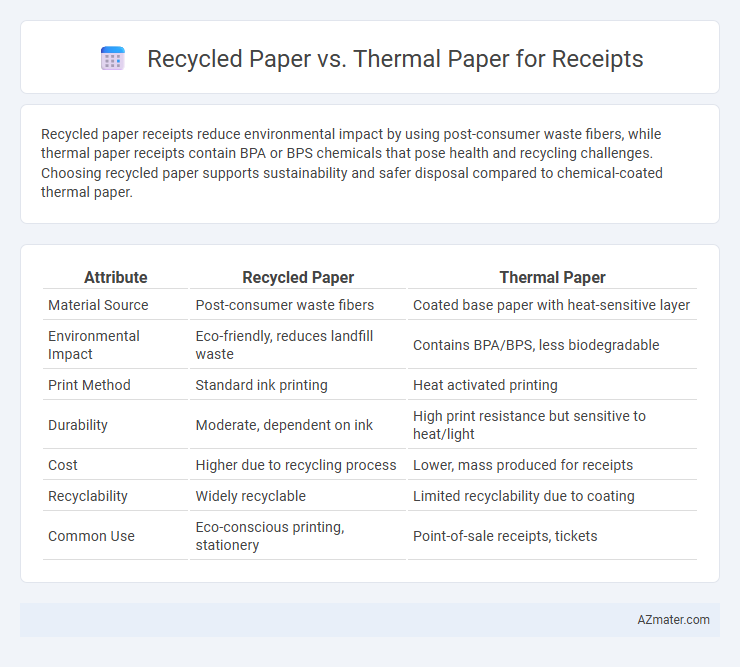Recycled paper receipts reduce environmental impact by using post-consumer waste fibers, while thermal paper receipts contain BPA or BPS chemicals that pose health and recycling challenges. Choosing recycled paper supports sustainability and safer disposal compared to chemical-coated thermal paper.
Table of Comparison
| Attribute | Recycled Paper | Thermal Paper |
|---|---|---|
| Material Source | Post-consumer waste fibers | Coated base paper with heat-sensitive layer |
| Environmental Impact | Eco-friendly, reduces landfill waste | Contains BPA/BPS, less biodegradable |
| Print Method | Standard ink printing | Heat activated printing |
| Durability | Moderate, dependent on ink | High print resistance but sensitive to heat/light |
| Cost | Higher due to recycling process | Lower, mass produced for receipts |
| Recyclability | Widely recyclable | Limited recyclability due to coating |
| Common Use | Eco-conscious printing, stationery | Point-of-sale receipts, tickets |
Introduction to Receipt Paper Types
Receipt paper types primarily include recycled paper and thermal paper, each serving distinct business needs. Recycled paper is eco-friendly, made from post-consumer waste, and suits ink-based printers, making it ideal for companies prioritizing sustainability. Thermal paper features a heat-sensitive coating that produces images without ink, offering faster print speeds and crisp text, commonly used in retail and hospitality sectors for efficient transaction recording.
What is Recycled Paper?
Recycled paper is made from recovered fibers, including post-consumer and pre-consumer waste, reducing the demand for virgin wood pulp and lowering environmental impact. It maintains durability and print quality suitable for receipts, offering a sustainable alternative to traditional papers. Unlike thermal paper, recycled paper does not rely on chemical coatings, making it more environmentally friendly and easier to recycle.
What is Thermal Paper?
Thermal paper is a specially coated paper designed to change color when exposed to heat, making it ideal for receipt printing without the need for ink or ribbons. Its smooth surface and heat-sensitive chemical layer enable quick, efficient printing with thermal printers commonly used in retail and hospitality industries. Unlike recycled paper, thermal paper offers superior print clarity and durability but often lacks eco-friendly attributes due to chemical coatings.
Environmental Impact: Recycled Paper vs Thermal Paper
Recycled paper receipts significantly reduce deforestation and landfill waste due to their use of post-consumer fibers and increased recyclability, lowering overall environmental footprint. Thermal paper contains BPA or BPS chemicals that pose health risks and complicate recycling processes, contributing to environmental pollution and hazardous waste. Choosing recycled paper receipts supports sustainable forestry practices and diminishes toxic chemical exposure, making them a more eco-friendly option compared to thermal paper.
Cost Comparison: Recycled Paper vs Thermal Paper
Recycled paper receipts generally incur lower material costs due to their use of post-consumer waste fibers, making them more budget-friendly for businesses prioritizing sustainability. Thermal paper receipts, while often more expensive per roll, reduce printing costs by eliminating the need for ink or toner, offering long-term savings in consumable expenses. Evaluating the total cost of ownership depends on factors like print volume, eco-conscious branding, and maintenance requirements, with recycled paper benefiting cost-wise from lower raw material prices and thermal paper favoring efficiency in printing operations.
Print Quality and Durability
Recycled paper receipts often exhibit lower print quality with less sharp text and reduced contrast compared to thermal paper, which delivers crisp, clear images due to its heat-sensitive coating. Thermal paper provides superior durability against fading, moisture, and smudging, ensuring longer-lasting receipts ideal for record-keeping and customer reference. The thermal printing process also enhances barcode readability, improving scanning accuracy and efficiency in retail environments.
Health and Safety Concerns
Recycled paper receipts often contain fewer harmful chemicals compared to thermal paper, which commonly uses bisphenol A (BPA) or bisphenol S (BPS), substances linked to hormonal disruptions and health risks upon skin contact. Handling thermal paper receipts can lead to the absorption of these toxic compounds, raising concerns for cashiers and frequent handlers. Choosing recycled paper receipts reduces exposure to these hazardous chemicals, promoting safer health conditions and minimizing environmental impact.
Compatibility with POS Systems
Recycled paper receipts offer broad compatibility with most thermal and impact POS printers, making them a versatile choice for businesses aiming to reduce environmental impact without sacrificing functionality. Thermal paper, specifically designed for direct thermal printers, ensures sharp print quality and quick drying times but lacks compatibility with non-thermal devices, potentially limiting its use in certain POS setups. Selecting the right paper type depends on the specific printer technology in use and the desired balance between sustainability and print performance.
Regulatory and Compliance Issues
Recycled paper receipts comply with environmental regulations such as the EU Timber Regulation and the U.S. EPA's guidelines, promoting sustainable sourcing and reducing deforestation impact. Thermal paper receipts often contain BPA or BPS chemicals, which face regulatory restrictions in regions like California and the EU due to health concerns related to endocrine disruption. Businesses must balance compliance by choosing recycled paper for eco-friendly standards or BPA-free thermal paper to meet chemical safety regulations in receipt production.
Making the Right Choice for Your Business
Choosing between recycled paper and thermal paper for receipts depends on your business priorities such as sustainability and cost efficiency. Recycled paper offers eco-friendly credentials by reducing waste and conserving resources, while thermal paper provides faster printing and durability but may contain BPA or BPS chemicals. Balancing environmental impact with operational needs ensures the right receipt paper enhances your brand image and meets customer expectations.

Infographic: Recycled paper vs Thermal paper for Receipt
 azmater.com
azmater.com